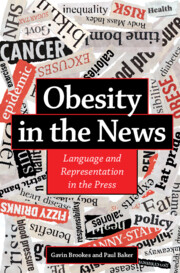Book contents
- Obesity in the News
- Obesity in the News
- Copyright page
- Contents
- Figures
- Tables
- Acknowledgements
- 1 Introduction
- 2 The Way In
- 3 Studying Difference
- 4 Change over Time
- 5 Shaming and Reclaiming
- 6 Healthy Body
- 7 Gendered Discourses of Obesity
- 8 ‘A Disease of the Poor’? Obesity and Social Class
- 9 Going ‘Below-the-Line’
- 10 Conclusion
- References
- Index
8 - ‘A Disease of the Poor’? Obesity and Social Class
Published online by Cambridge University Press: 16 November 2021
- Obesity in the News
- Obesity in the News
- Copyright page
- Contents
- Figures
- Tables
- Acknowledgements
- 1 Introduction
- 2 The Way In
- 3 Studying Difference
- 4 Change over Time
- 5 Shaming and Reclaiming
- 6 Healthy Body
- 7 Gendered Discourses of Obesity
- 8 ‘A Disease of the Poor’? Obesity and Social Class
- 9 Going ‘Below-the-Line’
- 10 Conclusion
- References
- Index
Summary
In this chapter, obesity representations are analysed in terms of the ways they intersect with discourses around social class. Specifically, the analysis focuses on the representation of four social class groups: i) upper class, ii) middle class, iii) working class and iv) underclass. The analysis points to a range of ways in which representations of these specific social class groups intersect with and contribute towards the broader representation of obesity. These representations are complex, with few straightforward patterns. However, generally, there are telling differences between newspapers with different political leanings. While those on the left of the political spectrum argue for the role of social inequality as a contributing factor in the development of obesity, those on the right argue that obesity is something that is not influenced by social class, as it exists at all class levels. Instead, newspapers to the political right argue that obesity results from individual factors, such as lack of self-control and over-dependence on the ‘nanny state’.
Keywords
- Type
- Chapter
- Information
- Obesity in the NewsLanguage and Representation in the Press, pp. 203 - 228Publisher: Cambridge University PressPrint publication year: 2021



